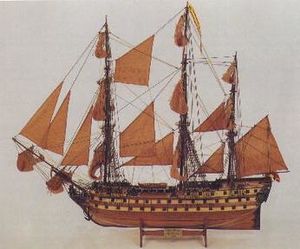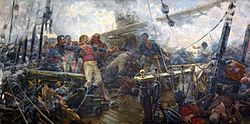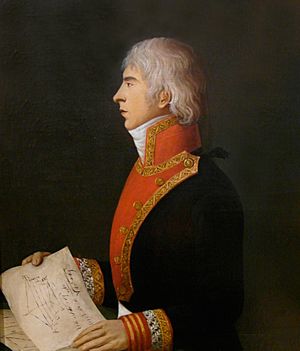Spanish ship San Juan Nepomuceno facts for kids

San Juan Nepomuceno
|
|
Quick facts for kids History |
|
|---|---|
| Name | San Juan Nepomuceno |
| Namesake | John of Nepomuk |
| Ordered | 20 September 1763 |
| Builder | Juan Donesteve |
| Laid down | 19 June 1765 |
| Launched | 18 October 1766 Guarnizo (Cantabria) |
| Captured | 22 October 1805 by Royal Navy |
| Name | HMS Berwick |
| Acquired | Captured 22 October 1805 |
| Renamed | HMS San Juan |
| Fate | Paid off & sold 8 January 1816 |
| General characteristics | |
| Type | Third-rate ship of the line |
| Tons burthen | 1,740 tons bm |
| Length | 181 ft (55 m) |
| Beam | 47 ft 4 in (14.43 m) |
| Height | 146 ft (45 m) |
| Depth of hold | 21 ft 3 in (6.48 m) |
| Sail plan | Full-rigged ship |
| Complement | 640 |
| Armament |
|
The San Juan Nepomuceno was a powerful Spanish warship. It was a "ship of the line," meaning it was a large, strong ship designed for battles in a line formation. This ship was built in 1765 in Guarnizo, Cantabria.
Like many Spanish ships from the 1700s, it was named after a saint, John of Nepomuk. The San Juan Nepomuceno was known for being very well-built and good at sailing. Later, during the Battle of Trafalgar, the British Royal Navy captured it. They renamed it first HMS Berwick, then HMS San Juan. The ship was eventually taken out of service in 1816.
Contents
What Was the San Juan Nepomuceno?
The San Juan Nepomuceno had several "sister ships." These were other ships built using the same design. Her sister ships included San Pascual, San Francisco de Asis, San Lorenzo, Santo Domingo, and San Agustín.
When it was first built, the ship had 74 cannons. These cannons were of different sizes, including 28 large 24-pounders and 30 slightly smaller 18-pounders. It also had smaller 12-pounder and 8-pounder cannons. The ship needed a large crew of about 530 people to operate it. This included officers, midshipmen, and many sailors. The ship could carry enough food for 60 days and water for 80 days.
Early Adventures
In 1793, the San Juan Nepomuceno joined British and Spanish forces. They took control of Toulon, a city in France. This was under the command of Admiral Don Juan de Lángara.
Four years later, in 1797, the ship was part of a Spanish fleet. This fleet fought against the British at the Battle of Cape St. Vincent.
The Epic Battle of Trafalgar
The most famous event in the ship's history was the Battle of Trafalgar. This huge naval battle happened on October 21, 1805. Even though the San Juan Nepomuceno was badly damaged, it fought bravely. Its masts were broken by Admiral Nelson's cannons.
A Captain's Brave Stand
The ship was commanded by Don Cosme Damian Churruca. He became a hero for the Spanish people because of his courage. The San Juan Nepomuceno was one of the last ships still fighting. Most French ships had already given up, and many Spanish ships were captured.
Captain Churruca had given a special order. He told his crew to "nail the flag" to the highest mast. This meant they would not surrender easily. Usually, ships would lower their flag to show they were giving up. Nailing the flag was a way to show everyone that they would fight to the very end.
As the battle continued, Captain Churruca was badly wounded. A cannonball tore off his leg. The ship's deck was covered in blood from his wounded and dead sailors. But he kept ordering his cannons to fire. Even when he was dying, Churruca told his officers not to surrender. He wanted them to keep fighting as long as he was alive.
His officers kept their promise. After Churruca died, command went to Francisco de Moyna. He continued the fight until he was also killed. The next officer in command also refused to give up. However, the ship was surrounded by six enemy ships. These included Defiance, Tonnant, and Dreadnought.
To stop the ship from sinking with all the wounded people trapped inside, the last officer alive on the San Juan Nepomuceno finally surrendered. By then, over 400 people on board were either dead or injured.
After the Battle of Trafalgar, the British took the San Juan Nepomuceno into their navy. It was briefly called HMS Berwick before its name was changed to HMS San Juan.
To honor Captain Churruca's bravery, his cabin on the ship had a special brass plate with his name on it. Anyone who entered his cabin had to take off their hat as a sign of respect for such a brave enemy.
The ship first served as a "hulk" at Gibraltar from 1805 to 1808. A hulk is an old ship that is no longer used for sailing but serves as a floating base. In September 1808, it became a "prison ship." This meant it was used to hold prisoners.
During the Peninsular War, the San Juan was changed to be the main ship for a group of smaller gunboats in Gibraltar. It was re-rated as a "sloop," a type of warship. Commander Thomas Vivion took charge in 1810. Later, Commander James Tillard took command in 1812. There were 14 lieutenants who each commanded a gunboat. Since the gunboats were small, these lieutenants lived aboard the San Juan.
Later, the San Juan served as the main ship for admirals in charge of Gibraltar. In 1813, it was the flagship for Rear Admiral Samuel Hood Linzee. In 1814, it was the flagship for Rear Admiral Charles Elphinstone Fleeming.
Its last job began in October 1814. It went back to being a base hulk under Lieutenant Charles M'Kenzie. The San Juan was finally sold in Gibraltar on January 8, 1816.



